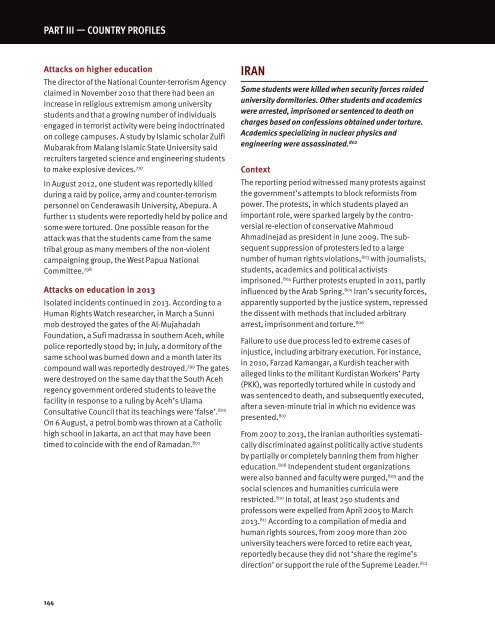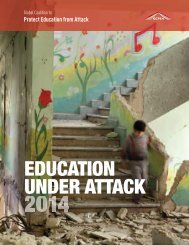You also want an ePaper? Increase the reach of your titles
YUMPU automatically turns print PDFs into web optimized ePapers that Google loves.
PART III — COUNTRY PROFILeSAttacks on higher educationThe director of the National Counter-terrorism Agencyclaimed in November 2010 that there had been anincrease in religious extremism among universitystudents and that a growing number of individualsengaged in terrorist activity were being indoctrinatedon college campuses. A study by Islamic scholar ZulfiMubarak from Malang Islamic State University saidrecruiters targeted science and engineering studentsto make explosive devices. 797In August 2012, one student was reportedly killedduring a raid by police, army and counter-terrorismpersonnel on Cenderawasih University, Abepura. Afurther 11 students were reportedly held by police andsome were tortured. One possible reason for theattack was that the students came from the sametribal group as many members of the non-violentcampaigning group, the West Papua NationalCommittee. 798Attacks on education in 2013Isolated incidents continued in 2013. According to aHuman Rights Watch researcher, in March a Sunnimob destroyed the gates of the Al-MujahadahFoundation, a Sufi madrassa in southern Aceh, whilepolice reportedly stood by; in July, a dormitory of thesame school was burned down and a month later itscompound wall was reportedly destroyed. 799 The gateswere destroyed on the same day that the South Acehregency government ordered students to leave thefacility in response to a ruling by Aceh’s UlamaConsultative Council that its teachings were ‘false’. 800On 6 August, a petrol bomb was thrown at a Catholichigh school in Jakarta, an act that may have beentimed to coincide with the end of Ramadan. 801IRANSome students were killed when security forces raideduniversity dormitories. Other students and academicswere arrested, imprisoned or sentenced to death oncharges based on confessions obtained under torture.Academics specializing in nuclear physics andengineering were assassinated. 802ContextThe reporting period witnessed many protests againstthe government’s attempts to block reformists frompower. The protests, in which students played animportant role, were sparked largely by the controversialre-election of conservative MahmoudAhmadinejad as president in June 2009. The sub -sequent suppression of protesters led to a largenumber of human rights violations, 803 with journalists,students, academics and political activistsimprisoned. 804 Further protests erupted in 2011, partlyinfluenced by the Arab Spring. 805 Iran’s security forces,apparently supported by the justice system, repressedthe dissent with methods that included arbitraryarrest, imprisonment and torture. 806Failure to use due process led to extreme cases ofinjustice, including arbitrary execution. For instance,in 2010, Farzad Kamangar, a Kurdish teacher withalleged links to the militant Kurdistan Workers’ Party(PKK), was reportedly tortured while in custody andwas sentenced to death, and subsequently executed,after a seven-minute trial in which no evidence waspresented. 807From 2007 to 2013, the Iranian authorities systematicallydiscriminated against politically active studentsby partially or completely banning them from highereducation. 808 Independent student organizationswere also banned and faculty were purged, 809 and thesocial sciences and humanities curricula wererestricted. 810 In total, at least 250 students andprofessors were expelled from April 2005 to March2013. 811 According to a compilation of media andhuman rights sources, from 2009 more than 200university teachers were forced to retire each year,reportedly because they did not ‘share the regime’sdirection’ or support the rule of the Supreme Leader. 812144



